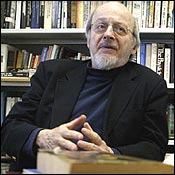
In the classic tradition of war literature, E. L. Doctorow’s The March—a dramatization of Sherman’s slash-and-burn tear through the South at the end of the Civil War—may remind many readers of more-current events. After all, this is the nineteenth-century version of shock and awe, with riotous soldiers, freed slaves, and fleeing Southerners operating as a sort of traveling green zone, “a floating world,” Doctorow explains, “in which all of the security and stability came from being on the move.” Yet Doctorow hedges when asked about Iraq parallels. “I don’t probe too deeply into that. But when you write about the past, you’re writing about the present.” The great American historical novelist, best known for Ragtime, had been playing with the notion of writing a Civil War novel for twenty years. (The topic appears to be on many minds: The March faces another would-be Civil War blockbuster this fall, Robert Hicks’s debut novel, The Widow of the South.) Doctorow notes that he’s not himself a Civil War buff: “If I was, I probably wouldn’t have written this novel.” The battles are accurately depicted, to be sure, but not from an omniscient bird’s-eye view. Instead, in classic Doctorow style, readers whirl within a kaleidoscope of close-up narratives by everyone from a freed slave girl passing for white to the mercurial Sherman himself (plus a couple of opportunists whose baser instincts leaven the pathos with dark humor). In the end, what textbooks have rendered as America’s triumph over slavery emerges here as something we’re all too familiar with: a Pyrrhic victory. “One could propose that in a way, the South won the war,” says Doctorow, ticking off segregation, lynchings, and Republican-campaign smear tactics. “The misery and devastation are still a scar in our history. It didn’t work out the way everyone hoped it would.”
The March
By E. L. Doctorow
Random House, September 20 ($25.95).
